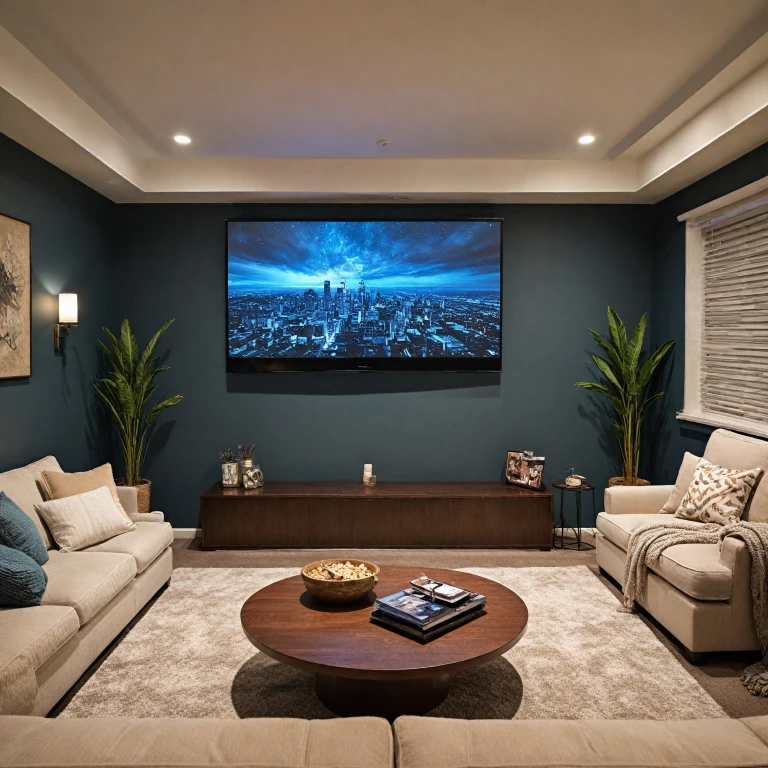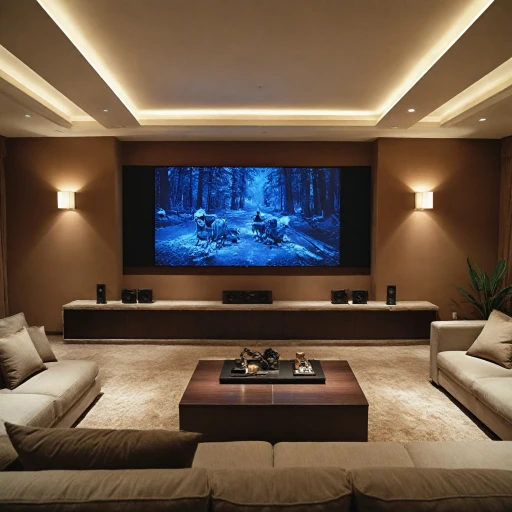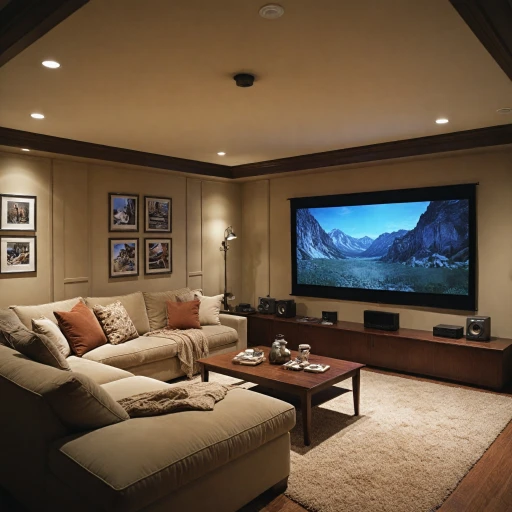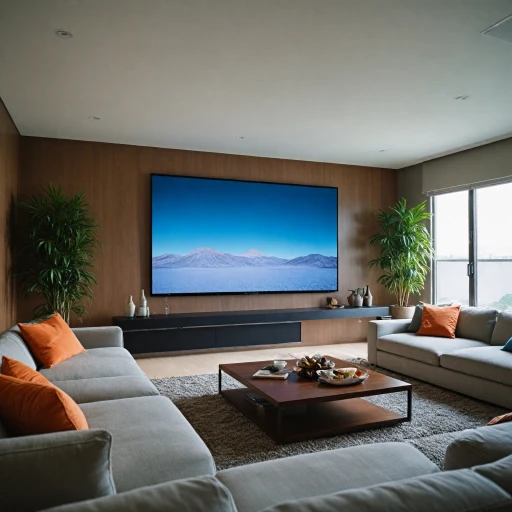Understanding Short Throw Projectors
The Magic Behind Short Throw Projectors
Short throw projectors have revolutionized the way we enjoy our favorite movies and shows in a home theater setting. Unlike traditional projectors that require a significant distance from the screen to project large images, short throw projectors can deliver a stunning visual experience from a much closer range. This makes them ideal for small spaces or unique room arrangements, where mounting options might be limited.
These projectors work by utilizing a specialized lens that can cast a large image while being placed close to the screen. This proximity not only maximizes space efficiency but also reduces the risk of shadows or glare caused by objects and viewers crossing the projection light path. The result is a vivid and uninterrupted viewing experience that's perfect for high-definition video playback.
One common feature of short throw and ultra short throw (UST) projectors is their ability to work effectively with ambient light rejecting (ALR) screens. These specialized screens are designed to reflect projection light while absorbing ambient light, maintaining picture clarity even in well-lit environments. This ensures that colors stay rich and details remain sharp, providing an enhanced viewing experience similar to what's seen with high-end HDTV setups.
The rise of elite screens specifically designed for short throw projectors has further expanded the appeal of this technology. These screens can include options like fixed frame or floor rising designs, catering to diverse setup preferences and aesthetic needs. With careful consideration of screen material and gain, a well-paired short throw projector and screen can rival premium home theatre systems at a more accessible price point.
Benefits of Short Throw Projector Screens
Advantages of Using Short Throw Projector Screens
Short throw projector screens come with a range of benefits that make them a preferred choice for home theaters. They are designed to provide an excellent viewing experience even in rooms where space is limited. Let's explore some key advantages.- Space Efficiency: One of the primary benefits is that these screens are ideal for small spaces. Short throw projectors, in contrast to traditional projectors, can project a large image from a close distance, minimizing the need for a vast room.
- Reduced Shadows: Short throw and ultra short throw projectors minimize shadow interference, making the viewing experience more immersive. The projector sits closer to the screen, so when someone walks in front of the screen, it does not obstruct the image.
- Enhanced Image Quality: These screens often come with features like Ambient Light Rejecting (ALR) material which optimizes visual clarity even in bright rooms. This technology enhances the contrast and color accuracy, giving you a great picture without needing complete darkness.
- Easy Installation: Installing a short throw projector is generally less complicated than traditional setups. With fewer concerns about throw distance, screens can be installed quickly, and many come with fixed frame options for easy mounting.
- Cost-Effective: Compared to extensive home theater setups, short throw projector screens and projectors offer a more affordable way to achieve a cinema-like experience. The reduction in space requirements often lowers the overall setup cost as well.
- Versatility: Short throw projectors can be used in a variety of settings, from living rooms to dedicated home theater spaces. They are adaptable, supporting both floor rising and fixed frame installations, providing flexibility in usage.
Choosing the Right Screen for Your Setup
Selecting the Perfect Screen for Your Viewing Space
When it comes to picking the right projection screen for your short throw setup, understanding the key factors is crucial. With a wide range of options available, finding a screen that complements your projector can make a world of difference. Here are some tips to guide your decision:
- Screen Material: The choice of material impacts the quality of your viewing experience. Make sure to go for a material that suits your room conditions, such as an ambient light rejecting (ALR) screen, which helps minimize the effect of light in well-lit spaces.
- Size and Aspect Ratio: Match the screen size with the space and your projector’s throw capabilities. An ultra short throw (UST) projector often pairs best with your selected screen size, ensuring an optimal viewing experience.
- Fixed Frame vs. Retractable: Consider the design that matches your aesthetic and functionality needs. A fixed frame screen often provides better tension and flatness, while a floor rising or retractable screen offers flexibility and can be neatly hidden away when not in use.
- Gain: Gain refers to the reflectivity of the screen. High gain screens are suitable for brighter displays, but if your setup prioritizes color accuracy, a lower gain can be advantageous.
Considering these factors and aligning them with your room environment will lead to a satisfying investment. For detailed insights and comparisons of various projectors and screens, including popular brands like Elite Screens, make sure to explore home theater projector guides online. This knowledge will assist you in making an informed choice that balances price and performance for your needs.
Installation Tips for Optimal Performance
Ensuring the Perfect Setup for Your Short Throw Projector
Setting up your short throw projector screen effectively is crucial for optimal viewing quality. Understanding how to position your projector and screen can make all the difference in creating a cinema-like experience in your home.- Proper Distance: With short throw or ultra short throw projectors, the distance between the projector and screen is critical. Unlike standard projectors, they require minimal space. Make sure to measure accurately; typically, a short throw projector requires less than half of the screen’s width as a distance, while an ultra short can be placed right next to the screen.
- Screen Material: The choice of screen material affects clarity and color accuracy. Materials with a higher gain will reflect more light, improving brightness in ambient light conditions. An ALR (ambient light rejecting) screen can significantly enhance the image quality by minimizing the impact of ambient light in the room.
- Mounting Height: To avoid image distortion, align the projector with the center of the screen. For fixed frame screens, ensure the projector is at the correct vertical angle without tilting, as this could cause a keystone effect.
- Frame and Screen Alignment: It's essential that the screen is tightly fixed within its frame projector setup, preventing sagging or creasing that can disrupt image projection. Fixed frame screens offer great stability and are often preferred for permanent setups.
Maintaining Your Projector Screen
Ensuring Longevity and Functionality
Maintaining your short throw projector screen is essential to prolong its life and ensure peak performance. Regular care can prevent common issues and maintain the high-quality viewing your unit offers. Here are some tips:- Regular Cleaning: Dust and dirt can accumulate on the screen, affecting picture quality. Use a gentle, non-abrasive cloth to wipe the screen's surface. If your screen is suitable for it, a mild cleaning solution may be used, ensuring it doesn’t damage the screen material like ALR or HDTV screens.
- Inspect for Damage: Frequent checks for tears, wrinkles, or any damage on fixed frame screens or floor rising models can help address problems before they worsen. Regular inspections are particularly crucial for high-usage environments with projection screens.
- Proper Storage: When not in use, especially for portable models, ensure the screen is stored in a clean, dry place. This protects the fabric and mechanics of your floor rising or ultra-short throw setup.
- Environmental Considerations: Install your screen in environments with controlled light and ambient conditions to maintain its performance. High ambient light and dust can negatively impact image clarity and brightness, particularly for ultra short throw projectors.
- Calibrate and Adjust Settings: Regularly calibrate your projector's color settings to align with the screen’s gain and light rejecting capabilities. Adjust for factors like ultra-ready features or specific screen inch preferences, ensuring an optimal display.
Troubleshooting Common Issues
Addressing Common Setbacks
When you invest in a high-quality short throw projector screen for your home theater, encountering technical glitches can be frustrating. However, understanding common issues and their remedies can preserve your viewing pleasure. Here’s a guide to troubleshooting some frequent problems:- Image Distortion: If you're experiencing warped or wavy visuals, ensure your projector screen is tightly secured to its fixed frame. Check the tension, as loose frames can cause irregular projections. Opting for a high-gain screen material can help enhance image clarity in environments with ambient light.
- Poor Image Quality: For blurred or unclear images, consider the distance between the projector and the screen. Throw projectors like ultra short throw (UST) models are designed for proximity, so ensure the distances align with the manufacturer's specifications. Choose a screen with ambient light rejecting (ALR) properties if your space cannot control ambient light effectively.
- Brightness Issues: If your projection appears dim, check the projector’s lamp life. Replacing it can often remedy brightness concerns. Additionally, using screens with reflecting surfaces or "floor rising" designs can amplify brightness effectively.
- Synchronization Problems: If the audiovisual sync is off, verify your connections. Ensure all HDMI cables are securely connected, and your projector’s software is updated to the latest version. Double-check your HDTV settings for any overlooked adjustments.
- Stability and Alignment: Misalignment is not uncommon. Adjust the positioning of the projector to refine alignment with the screen. Make sure your screen’s frame is leveled and secured; top-tier models like Elite Screens offer robust construction to aid stability.





